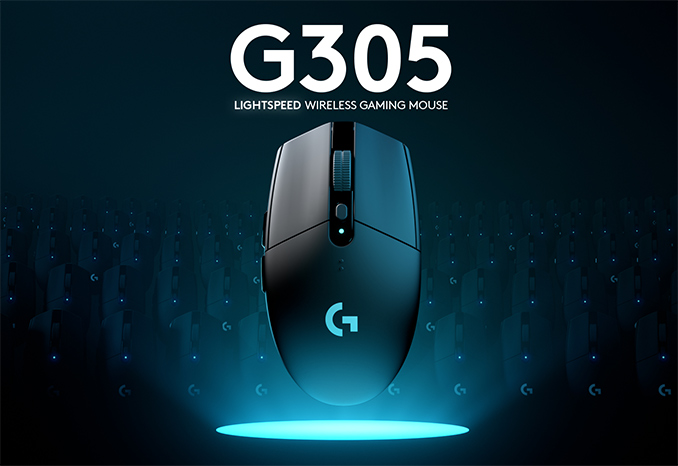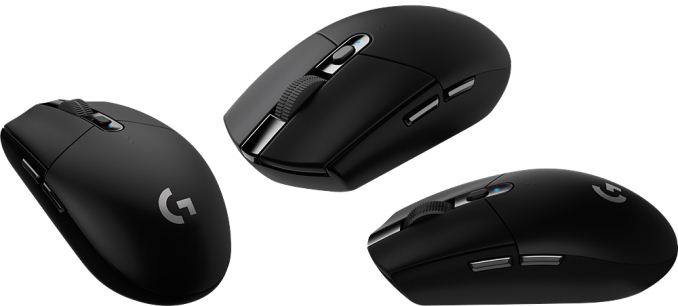Logitech Unveils G305 Mouse with Lightspeed Wireless, ‘Hero’ 12,000 DPI Sensor
by Anton Shilov on May 16, 2018 12:00 PM EST- Posted in
- Peripherals
- Logitech
- Mouse
- Mice
- Lightspeed
- G305

Logitech this week introduced its new entry-level gaming mouse that uses its proprietary Lightspeed wireless interconnection technology as well as its latest HERO sensor. The Logitech G305 mouse uses a proven ambidextrous form-factor but does not offer features like adjustable weight or RGB lighting.
The G305 is Logitech’s second mouse to feature the company’s latest HERO (high efficiency rated optical) sensor with 12,000 DPI sensitivity, up to 400 inches per second detection speed, and up to 40G acceleration. In addition, the mouse uses the proprietary Lightspeed wireless interconnection technology that allegedly cuts the input lag by improving the internal architecture, reducing the polling rate of wireless receivers to 1 ms, rising signal strength, applying a proprietary frequency hopping mechanism that uses the strongest interference-free channel, and optimizing software.
One of the advantages of Logitech’s HERO sensor (and to a degree Lightspeed technology) is a very long battery life. The manufacturer promises that the G305 mouse can last for 250 hours on one AA battery and up to nine months when its polling rate is reduced to 8 ms.
The Logitech G305 is outfitted with six programmable buttons, in line with other entry-level gaming mice. As for weight, it weighs only 99 grams, which some gamers might find too light, but which becomes an advantage when the mouse is used when travelling.
Logitech’s G305 Lightspeed wireless gaming mouse will be available in black and white later this month for a suggested retail price of $59.99. This price is a little bit lower when compared to Logitech’s G603 mouse featuring the HERO sensor as well as the Lightspeed technology ($69.99), but which is more expensive than the price of Logitech’s G502 (starts at $49.99) that has a previous-gen 12,000 DPI sensor, adjustable weight, 11 programmable buttons, and RGB lighting.
Related Reading
- Logitech Launches G603 ‘Lightspeed’: 12,000 DPI Hero Sensor, 1 ms Polling, 500 Hrs Battery
- Logitech Launches G203 Prodigy Gaming Mouse with A New 6000 DPI Sensor
- Logitech Announces The Ambidextrous G900 Chaos Spectrum Gaming Mouse
- Corsair Launches Glaive RGB Mouse: 16,000 DPI, Interchangeable Grips, LEDs
- Razer Announces The Lancehead Gaming Mice
- Razer Updates The DeathAdder Elite Gaming Mouse
- Logitech Formally Exits OEM Mouse Market
Source: Logitech













15 Comments
View All Comments
rocky12345 - Wednesday, May 16, 2018 - link
Looks like it would be a great mouse and the price is not to shabby as well. I might have to pick one up when they get to the stores.cosmotic - Wednesday, May 16, 2018 - link
Based on the product descriptions and marketing material of mice over the past 20 years, you would have thought the input lag and wireless problems had been completely solved. With every new release the truth comes out: wired mice still perform better.eva02langley - Wednesday, May 16, 2018 - link
Hey man, 1 ms is 0.06 frame per second for 60Hz. I am a street fighter player and we were arguing for 2 or 3 frames of input latency in SFV to be catastrophic, however it barely matter.To make a comparison, we are talking about 33-50 ms, for a highly reactionary fighting game.
1ms is not going to make a difference in competition. Human reaction are not that tight.
nerd1 - Wednesday, May 16, 2018 - link
Is anyone still using 60hz monitor? *gasp*Death666Angel - Wednesday, May 16, 2018 - link
Are there unlocked console games? Is FreeSync happening on consoles, yet?yasamoka - Friday, May 18, 2018 - link
https://www.blurbusters.com/faq/mouse-guide/Focus on this: https://www.blurbusters.com/wp-content/uploads/201...
hanselltc - Thursday, May 17, 2018 - link
Care to elaborate?Ktk - Thursday, May 17, 2018 - link
Of course, there are still benefits of wired mice like 100% uptime and far greater variety in form factor, but Logitech's wireless offerings perform on par with wired mice.Pro gamers sponsored by Logitech (in CSGO, Overwatch, if curious) have preferred Logitech's wireless offerings. Though they are sponsored, Logitech also offers wired mice. That being said I think your statement rings largely true for the other companies.
Roland00Address - Wednesday, May 16, 2018 - link
Some of these numbers seem so meaningless for me. 400 inches per second so that is literally 33 feet in a second, who is in a room that big? Okay but it is not about a single second but fractions of a second.So 400 inches per second that is 4 inches in 1/100th of a second, and .4 inches in 1/1000th of a second (which is the polling rate, 1000 times a second.)
But is this even useful or is it just placebo now? Literally it takes 13 microseconds for the first signals from the eyes to hit the brain and most processing takes 80 to 100 microseconds to START beginning. Similar numbers also occur with signals from your motor area of the brain (brodmann area 4) down the thalamus, brain stem, spinal chord, to peripheral nerves, and reaching the muscles to actually move the muscles and bones to DO THE THING.
Same thing with g forces, 40 Gs is rocket sled acceleration. By comparison
Roland00Address - Wednesday, May 16, 2018 - link
Damn I actually hit submit early in the previous post.Same thing with g forces, 40 Gs is rocket sled acceleration. By comparison the fastest race cars with G forces are between 4 to 8 Gs during the most rapid acceleration, rapid deceleration aka brakes (braking is more g forces than speeding up), and the most severe turns.
-----
I have no doubt this logitech mouse is better than other mice, but the marketing terms seem so superfluous with no point of reference and thus no *useful* subjectivity that I have no clue what they are trying to communicate. Bigger numbers are not really better, it is like monitors contrast ratio when we are not talking a specific pixel and its ability to change but instead talk about dynamic contrast ratio of comparing two different pixels on different areas of the monitor. (Aka x vs x*x)